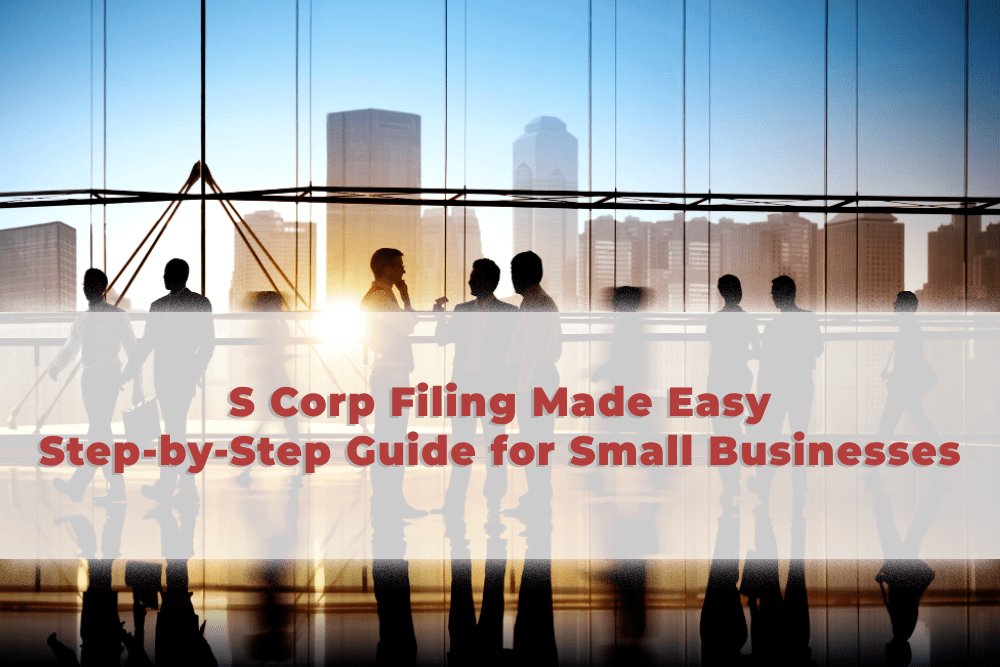Running a small business comes with many responsibilities, and one important task is ensuring you’re filing your taxes correctly. If you’re considering structuring your business as an S Corporation (S Corp), you’re in the right place. S Corps can offer tax benefits, but it’s essential to follow the correct steps when filing to avoid penalties and maximize savings. This guide will break down everything you need to know about S Corp filing, from start to finish, in easy-to-understand terms.
What Is an S Corp?
An S Corporation is a business entity that allows its income, deductions, and credits to pass through to shareholders for federal tax purposes. This means the business itself doesn’t pay federal income tax. Instead, the profits and losses are reported on the owners’ personal tax returns, avoiding double taxation like a C Corporation. It’s an excellent choice for many small business owners looking to save on taxes.
Step 1: Determine Eligibility
Before you can file as an S Corp, you need to ensure your business meets the requirements:
- Domestic Corporation: Your business must be based in the U.S.
- Eligible Shareholders: You can only have certain types of shareholders, such as individuals, estates, and certain trusts. Partnerships and corporations cannot be shareholders.
- 100 Shareholders Limit: An S Corp can have no more than 100 shareholders.
- One Class of Stock: Your business can only issue one class of stock.
If your business meets these requirements, you’re eligible to file as an S Corporation.
Step 2: File Form 2553 to Elect S Corp Status
Once you’ve confirmed that your business qualifies, the next step is filing IRS Form 2553. This is the official form you submit to elect S Corporation status with the IRS.
How to Complete Form 2553:
- Basic Information: Fill in your corporation’s name, address, and EIN (Employer Identification Number).
- Shareholder Information: List all eligible shareholders, including their Social Security Numbers and the number of shares they own.
- Filing Deadline: You must file this form within two months and 15 days of the start of the tax year in which you want the S Corp election to take effect.
- Sign and Submit: The form must be signed by all shareholders.
You can download the form directly from the IRS website here.
Step 3: Maintain Corporate Formalities
Even though an S Corp avoids double taxation, you still need to follow certain corporate formalities to maintain your status:
- Hold Regular Meetings: Your S Corp should hold shareholder and board meetings regularly. Keep minutes of these meetings.
- Keep Personal and Business Finances Separate: Ensure that your personal finances are kept separate from your business accounts.
- File Annual Reports: Depending on your state, you may need to file annual reports or other documents to remain in good standing.
Neglecting these formalities could put your S Corp status at risk and may result in fines or penalties.
Step 4: Understand the Tax Filing Process for an S Corp
After electing S Corp status, your tax filing obligations will change. Here’s a breakdown of what’s required.
Filing Your Taxes as an S Corp
As an S Corporation, you will need to file Form 1120-S with the IRS. This form reports your business income, deductions, and credits, similar to how a corporation files taxes. However, unlike a traditional corporation, the profits or losses flow through to the shareholders, who will report them on their personal tax returns.
- Distribute Schedule K-1: Along with Form 1120-S, you must provide each shareholder with a Schedule K-1. This form shows their share of the S Corp’s income, deductions, and credits.
- Quarterly Estimated Taxes Importance: Even as an S Corp, shareholders might need to pay quarterly estimated taxes on their share of the business’s income. This helps avoid underpayment penalties when filing your personal tax return.
You may also like to read:
Type of Business Entities (S corp, C corp, Partnerships)
When starting a business, choosing the right structure is crucial. Two popular options are C corporations and S…
Read More

Step 5: Avoid Common S Corp Pitfalls
There are several mistakes that small business owners often make when it comes to S Corp filing. Here are some pitfalls to avoid:
- Failing to File Form 2553 on Time: If you miss the deadline, your S Corp status will not take effect for that tax year, and you’ll have to wait until the following year to apply.
- Not Paying Yourself a Reasonable Salary: The IRS requires that S Corp owners who actively work in the business pay themselves a reasonable salary before taking distributions. If you don’t, you could be audited.
- Neglecting Quarterly Payments: Shareholders need to pay quarterly estimated taxes to avoid penalties. It’s important to calculate and pay these on time.
Benefits of S Corp Filing
The main reason many small business owners elect S Corp status is for the potential tax savings. Here are some of the key benefits:
- Avoid Double Taxation: Unlike a C Corporation, an S Corp avoids being taxed at the corporate level. All profits pass through to shareholders and are taxed at individual rates.
- Self-Employment Tax Savings: S Corp owners only pay self-employment taxes on their salary, not on the distributions they receive. This can significantly reduce your overall tax bill.
- Limited Liability: Like a corporation, an S Corp protects your personal assets from business liabilities.
Step 6: Stay on Top of S Corp Compliance
Once you’ve filed as an S Corp, it’s essential to stay compliant with all tax and legal requirements to maintain your status. Here’s what you need to do annually:
- File Form 1120-S: This form must be filed every year by March 15 (or the next business day if it falls on a weekend).
- Issue Schedule K-1: Shareholders must receive their Schedule K-1 forms so they can report their income on their personal returns.
- Quarterly Estimated Taxes: Make sure you and any other shareholders pay quarterly estimated taxes based on your expected income. This is critical to avoid penalties.
Step 7: Filing State Taxes as an S Corp
S Corps can also have state tax obligations depending on where your business is located. Some states recognize S Corporation status, while others treat S Corps like C Corporations for state tax purposes. Make sure you understand your state’s requirements.
For example, New York and California have additional S Corp filing fees or franchise taxes that must be paid each year. It’s essential to check with your state’s tax agency to ensure compliance.
Conclusion
Filing as an S Corporation can be a great way to save money on taxes and limit personal liability. However, it’s crucial to follow the right steps, from filing Form 2553 to staying compliant with corporate formalities and paying quarterly estimated taxes. By keeping these steps in mind, you can simplify the process and enjoy the benefits that come with S Corp status.




